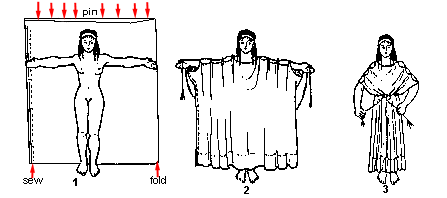Difference between revisions of "Chiton"
(not a stub) |
|||
| Line 1: | Line 1: | ||
| − | |||
[[Image:Chiton.jpg|thumb|Chiton made from [[linen]]]] | [[Image:Chiton.jpg|thumb|Chiton made from [[linen]]]] | ||
The [[chiton]] was a Greek garment worn by all genders. It varied in length as styles came and went. | The [[chiton]] was a Greek garment worn by all genders. It varied in length as styles came and went. | ||
Latest revision as of 17:44, 3 April 2016

The chiton was a Greek garment worn by all genders. It varied in length as styles came and went.
In history
There are two types of chiton: the Doric chiton and the later Ionic chiton. The Doric chiton is a single rectangle of woolen or linen fabric. It can be worn plain or with an overfold called an apotygma which is more common to women. It can be draped and fastened at the shoulder by pins (fibulae) or sewing, or by buttons. The Ionic chiton could also be made from linen or wool and was draped without the fold and held in place from neck to wrist by several small pins. A large belt called a zoster could be worn over the chiton, usually under the breast or around the waist.The chiton's length was greater than the height of the wearer, so excessive fabric was pulled above the belt, like a blouse.
Making a chiton
1. For a long chiton, the length of the material has to be the same as your height. When you fold it in half it should reach from finger-tip to finger-tip.
2.Sew along the side seam. Join the top edge at intervals with safety-pins or brooches, or by sewing. Don't forget to leave holes for your head and arms to go through. Slip it on over your head.
3.Tie a belt round your waist and pull up the extra material so that it hangs over the belt.
